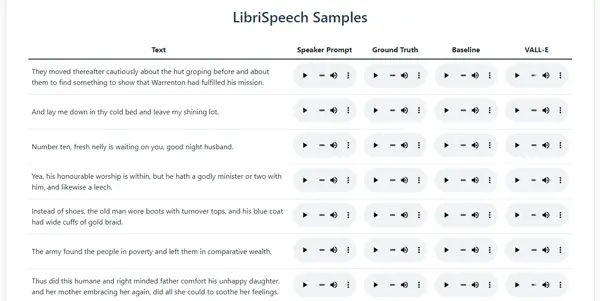Vall-E

Can reproduce a voice perfectly.
Vall-E: A Breakthrough in Voice Cloning Technology
Vall-E is a groundbreaking AI tool developed by Microsoft that demonstrates remarkable capabilities in voice cloning and synthesis. Unlike previous technologies, Vall-E excels at replicating a speaker's voice with exceptional fidelity, using only a three-second audio sample as a reference. This article will delve into its functionality, applications, and comparisons to other similar tools.
What Vall-E Does
Vall-E leverages a neural codec language model to achieve its impressive voice cloning feats. Given a short audio snippet (as little as 3 seconds), it can accurately synthesize the speaker's voice saying any given text. The generated audio maintains the speaker's unique vocal characteristics, including intonation, emotion, and even acoustic nuances. This is a significant advancement over previous methods that often resulted in robotic or unnatural-sounding synthetic speech.
Main Features and Benefits
- High Fidelity Voice Cloning: Vall-E's primary strength lies in its ability to reproduce a voice with unparalleled accuracy, surpassing many existing voice cloning technologies in terms of naturalness.
- Minimal Training Data: Requiring only a three-second audio sample significantly reduces the data collection and preprocessing burdens compared to other methods. This makes it more accessible and efficient.
- Emotional and Acoustic Preservation: Vall-E doesn't just replicate the speaker's timbre; it also convincingly mimics the emotional inflection and acoustic environment present in the original sample.
- Text-to-Speech Capabilities: The model converts text input into speech, using the cloned voice to deliver the message.
Use Cases and Applications
The potential applications of Vall-E are vast and span several industries:
- Personalized Voice Assistants: Imagine a voice assistant that sounds exactly like your loved one, or a customized voice for your brand, instantly enhancing user experience.
- Accessibility Technologies: Vall-E could enable people with speech impairments to communicate using their own synthesized voice.
- Audiobook Creation and Narration: Authors could create audiobooks narrated in their own voice, adding a personal touch to the listening experience.
- Content Creation and Dubbing: Producing high-quality dubbed content in a variety of languages would become significantly easier and more affordable.
- Digital Preservation of Voices: Vall-E can help preserve the voices of loved ones or historical figures by creating a digital replica from archived recordings.
Comparison to Similar Tools
Vall-E distinguishes itself from existing voice cloning tools in several key ways:
- Superior Naturalness: While other tools achieve voice cloning, Vall-E's output sounds considerably more natural and less robotic.
- Reduced Data Requirements: The three-second audio input requirement is significantly less than what other methods typically demand, making the process far more streamlined.
- Emotional Nuance: Vall-E's ability to convincingly replicate emotional context is a significant step forward in the field.
However, it's crucial to acknowledge ethical considerations surrounding voice cloning technology, similar to other AI tools. The potential for misuse, such as impersonation for malicious purposes, necessitates robust safeguards and responsible development.
Pricing Information
Currently, Vall-E is free for research purposes. Microsoft has not yet announced any commercial licensing or pricing plans. The future availability and cost of Vall-E for commercial applications remain to be seen.
Disclaimer: The information provided is based on publicly available knowledge about Vall-E at the time of writing. Specific details regarding future development, pricing, and accessibility might change. Always consult official sources for the most up-to-date information.